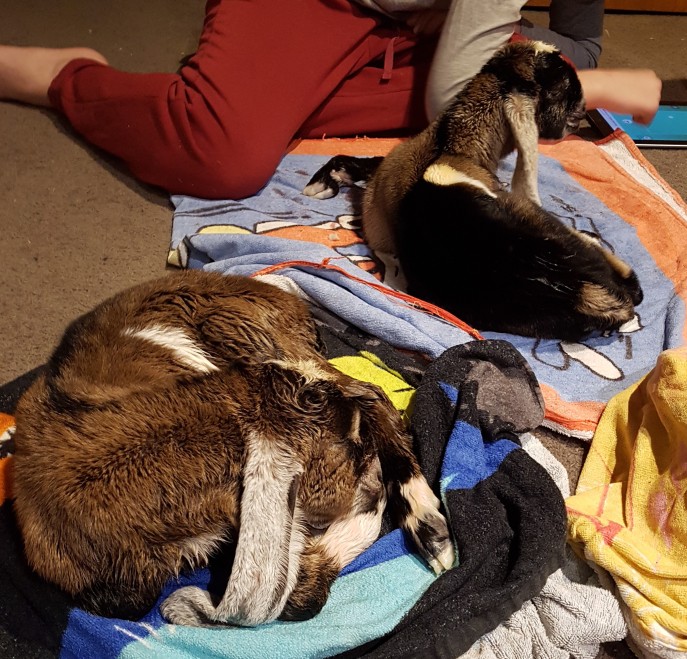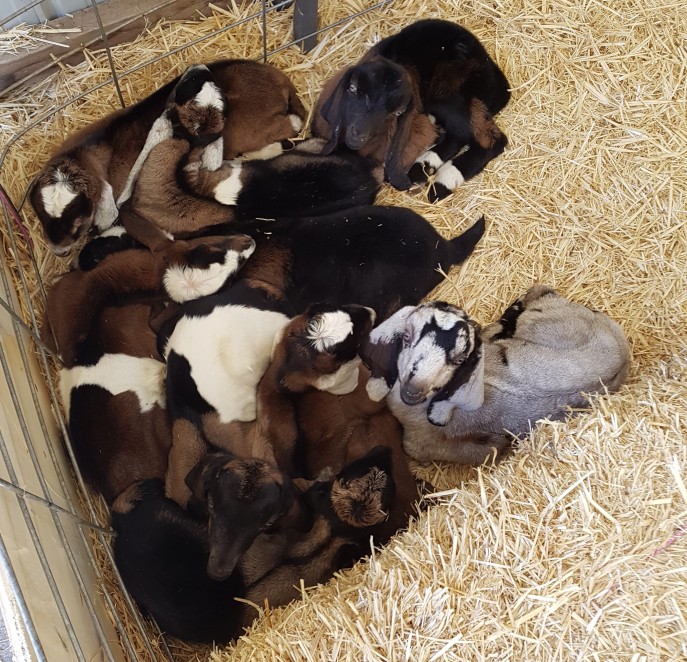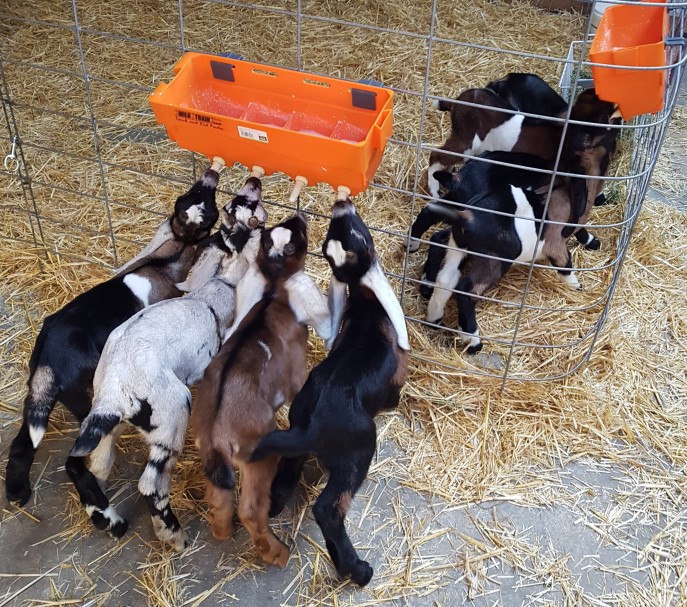The next morning I expected to find Rosanna either dead in her pen or with a prolapsed uterus or both, but she was at the gate ready to go out and spend the day in the paddock with her sisters. She asserted her position with headbutts to a few key players, and marched down the paddock with the other does who had kidded, who were all still calling out for their kids.
Rosanna’s doe kid, Georgia, would not take a bottle. She made a strange ‘mah’ sound that was not like the normal bleat of a newborn kid, and she walked slowly, falling down often. In stark contrast, her brother was hungry, talkative, and would not stay in one spot for a second. I kept them together in the house for the first couple of days, hoping that Johnny’s activity and contact would help Georgia’s little body figure out what to do.

Georgia and Johnny
It took ages to get Georgia dry, due to all of the lubricant and detergent that had been used to facilitate her birth. We had been tube feeding her each time her brother had a bottle, offering the teat first to no avail. By the afternoon she was bloated, seemed to be in pain, and I decided to take her to the vet to see if anything could be done.
The vet asked about my tubing techniques and gave some suggestions as to how to avoid getting air in Georgia’s stomach during tube feeding. She also diagnosed her as a ‘dummy kid’ based on her odd walk, odd voice and inability to suck. She sent us home with advice to keep tube feeding until Georgia could take a bottle and hope for the best.
The next morning I found Rosanna dead in the goat shed, curled up as though asleep. Presumably the drugs she had been given after her difficult birth kept her comfortable for long enough for her to lie down with her sisters and previous year’s kids, and quietly succumb to internal bleeding. I had never lost a doe at kidding before, despite assisting several. In a normal year it would have been a disaster, but under the circumstances it was just another drop in the bucket.
I put Georgia and Johnny out with the other kids, hoping that the throng of little bodies would help Georgia’s systems come online. In dummy kids, as with dummy foals, it is believed that a failure of the newborn’s body to respond to the prompts of birth to switch to ‘outside mode’ is the cause of the syndrome. Newborns are inactive with poor muscle tone and absent suck reflex. In foals there has been dramatic success with simulating the pressures of the journey through the birth canal using ropes. I read all I could find about dummy foals and dummy kids. One goat breeder told a story of a dummy kid she had who was ‘cured’ by an unrelated doe licking her like a newborn. But the likely outcome was that I would have to get milk into Georgia by any means possible until she was able to move onto solid food, if I was to keep her alive.

Kiddie pile – find all nine
After four days of tube feeding, Georgia was behind in her milk consumption and starting to look skinny compared to the others. She was doing okay, but slow, weak and unsteady on her feet. Continued tube feeding irritates the throat, and there was the concern that if she did try to suck and swallow she would find it painful, which would deter her from trying. At the end of day five, she finally took milk from a bottle. Only 150ml at first and her throat did seem sore, but over the next few days I kept her on four feeds a day and she started to catch up to the others. She had another visit to the vet that week to rule out joint ill, but her lameness was deemed to be related to her brain injury, and it resolved on its own.
It probably took a month before Georgia was 100%. She is still bottle fed, as there are only eight spots on the lamb feeders and nine kids, but she can drop 900ml at a feed, and leaps, climbs and bounces like all the others.

Lamb bar madness
The kids are now nine weeks old, and living full time in a small paddock in the back corner of the house yard. My other goats are all gone, except for two special goatlings, Dutch the buck, and Cosmo, a wether who keeps Dutch company. Those four are kept in the small paddocks at the front of the property, where nobody goes except me to check them. The hope is that I can get some kids from the two goatlings, who are daughters of my foundation buck Tazzy, and add them to the current nine to keep my herd viable for the future.
In the next few weeks we will find out if the kidsnatch has been successful. Previous kids started showing symptoms from 10-12 weeks. If we can get through to December without any signs of respiratory illness, we can start to look towards the future. Otherwise there will be more questions, more tests, and likely the end of my goat breeding enterprise.

What an ordeal… I’m so glad there are some happy stories in amongst all of this. The kids are just gorgeous 🙂